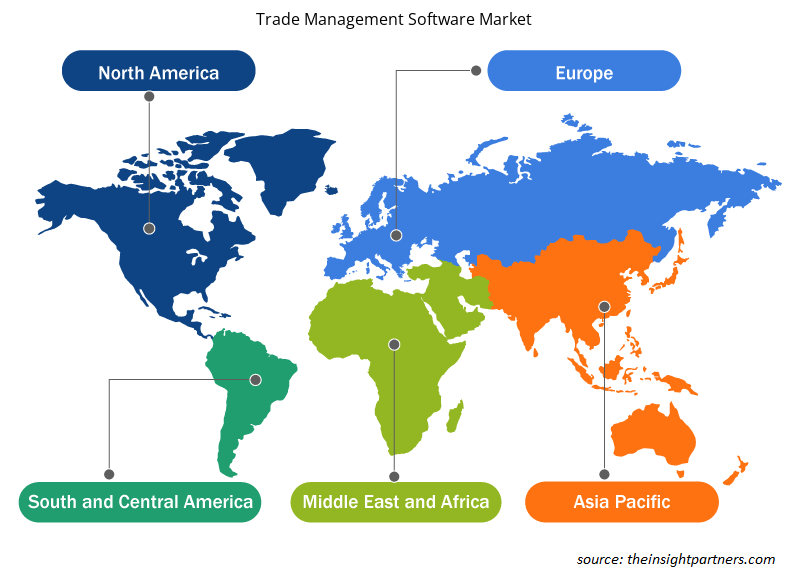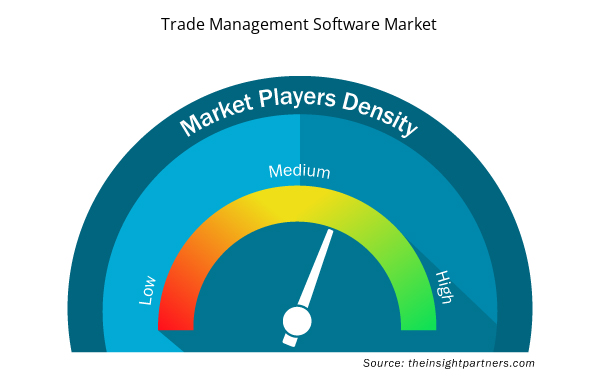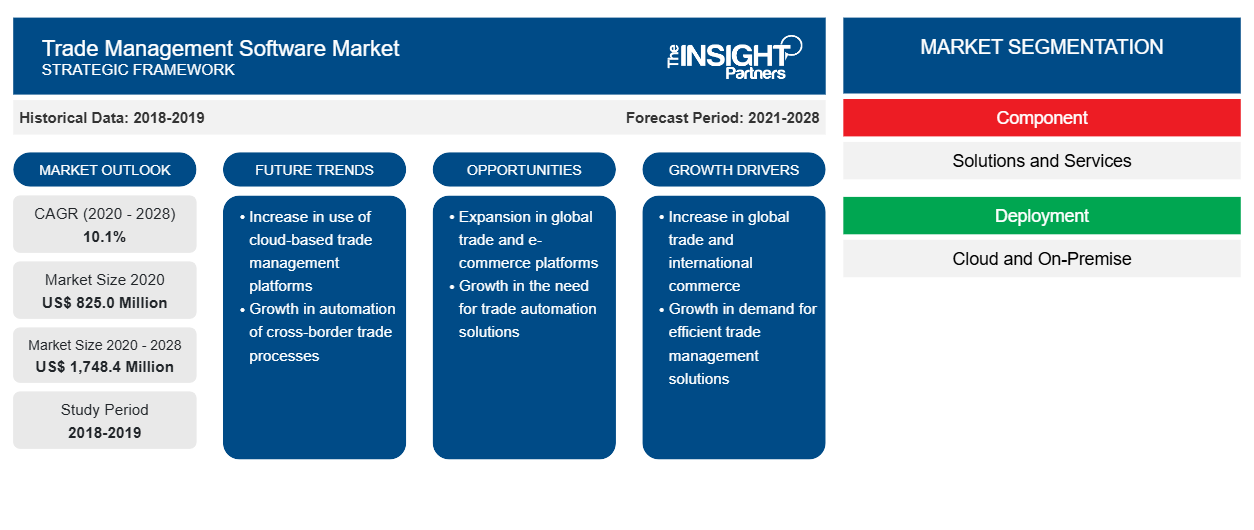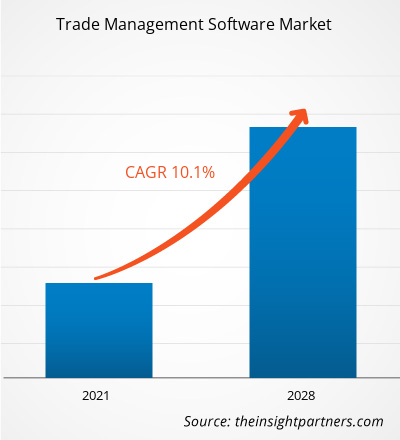[研究报告] 从收入来看,2020 年全球贸易管理软件市场价值为 8.25 亿美元,预计到 2028 年将达到 17.484 亿美元;预计在 2020 年至 2027 年的预测期内,复合年增长率为 10.1%。
贸易管理软件市场大致分为五个主要区域——北美、欧洲、亚太地区、中东和非洲以及 SAM。2020 年,亚太地区主导了贸易管理软件市场。亚太地区由许多发展中国家组成,这些国家的制造业都实现了高速增长;该地区已成为全球制造业中心。中国以及印度、韩国、台湾和越南等其他发展中国家正在吸引许多企业将其中低技能制造设施迁移到劳动力成本较低的邻国。此外,这些国家的政府正在采取措施,改善该地区的外国投资。多年来,该地区的制造业支出大幅增长,预计还将以可观的增长率增长。制造业支出的大幅增长和新技术的采用是推动该地区贸易管理软件需求的关键因素。
COVID-19 疫情对贸易管理软件市场的影响
自 2019 年 12 月以来,COVID-19 疫情一直影响着全球的每项业务。感染病毒的患者人数持续增长,迫使各国政府限制人员和货物的运输。由于工厂暂时关闭和产量低迷,制造业遭受了严重损失,阻碍了零售、电子商务和物流行业的增长。此外,政府实施的社交或物理距离措施限制了物流和其他服务提供商的运营。这种中断导致贸易业务下滑。这些逆境导致 2020 年 5 月全球贸易量与 2019 年 5 月的贸易量相比下降了 17.7%。2020 年前 5 个月的下降是普遍的,但主要影响了日本、美国和欧洲国家的出口。尽管 COVID-19 疫情造成了破坏,但随着企业在长期封锁后恢复,未来贸易可能会激增。随着社交距离措施的实施,电子商务、物流、零售等涉及贸易活动的行业正致力于采用贸易管理软件,以确保供应链速度,从而满足合规性。因此,COVID-19 带来的不确定性扩大了在物流中使用基于云的软件/SaaS 的范围。
定制此报告以满足您的需求
您可以免费定制任何报告,包括本报告的部分内容、国家级分析、Excel 数据包,以及为初创企业和大学提供优惠和折扣
- 获取此报告的关键市场趋势。这个免费样品将包括数据分析,从市场趋势到估计和预测。
市场洞察 – 贸易管理软件市场
降低成本和实时可视性
贸易是一个复杂的过程,涉及多种商品和信息在供应商、承运商和仓库网络中的流动。软件解决方案通过分析实时和现实世界的数据,帮助用户更精确、更轻松地处理这些复杂性,从而减少效率低下。这些软件系统的实施还改善了供应链功能,并提供了对运营的实时可见性。不同行业竞争力的提高是迫使它们投资自动化和数字化的主要力量。此外,采用基于云的解决方案可以增强对出口商品的实时可见性,并降低运营成本。区块链、人工智能 (AI) 和预测分析等新兴技术在物流运营中的实施将在未来几年进一步推动全球贸易管理软件市场的增长。
组件细分洞察
根据组件,贸易管理软件市场分为解决方案和服务。解决方案部分预计将在预测期内成为全球贸易管理软件市场的领先部分。解决方案部分包括贸易合规和国际贸易可视性和执行。此外,国际贸易可视性和执行操作包括跨境航运和运输。它们提供对国际贸易伙伴事件和流程的可视性。这些流程必须是国际性的,包括商业贸易伙伴之间的交易和协议。
部署细分洞察
根据部署,贸易管理软件市场分为本地部署和云部署。在预测期内,云部署很可能成为全球贸易管理软件市场的领先部分。云部署主要被中小型企业采用。与本地部署相比,云部署的主要优势包括拥有成本低、维护和升级成本低以及可访问最新功能。
组织规模细分洞察
根据组织规模,贸易管理软件市场分为小型企业、中型企业和大型企业。大型企业细分市场预计将在预测期内成为全球贸易管理软件市场的领先细分市场。在全球范围内,许多组织对贸易管理软件的需求都在增加,以提高效率并最大限度地降低总体运营成本。采用这种软件是大型企业构建合适供应链和获得整体运营灵活性的常见做法。
行业细分洞察
根据行业,预计物流和运输部门将成为预测期内全球贸易管理软件市场的领先部门。对提供超越传统服务的物流供应商的需求正在上升。在某些情况下,第三方物流供应商运营或管理其合作伙伴的外贸区。此外,在其他情况下,他们提供与商品生产或采购相关的仓储以及增值服务。此外,他们组织所有必要的物流和运输流程,以高效、经济地将商品从源头转移到最终用户。
市场参与者正专注于新产品的创新和开发,通过在其产品中集成先进的技术和功能来与竞争对手竞争。
- 2021年1月,SAP香港与咨询巨头德勤合作,为从事跨境贸易的企业提供实质性优惠。
- 2019年1月,Bamboo Rose推出订阅模式服务,帮助客户更好地规划、创新并与其多企业零售社区合作,从而节省10%至30%的技术投资。
- 2019 年 3 月,汤森路透以未公开的金额收购了全球贸易管理 (GTM) 软件提供商 Integration Point,这笔交易大大扩大了其北美进口商和出口商客户群。
贸易管理软件市场区域洞察
Insight Partners 的分析师已详尽解释了预测期内影响贸易管理软件市场的区域趋势和因素。本节还讨论了北美、欧洲、亚太地区、中东和非洲以及南美和中美洲的贸易管理软件市场细分和地理位置。

- 获取贸易管理软件市场的区域特定数据
贸易管理软件市场报告范围
| 报告属性 | 细节 |
|---|---|
| 2020 年市场规模 | 8.25 亿美元 |
| 2028 年市场规模 | 17.484 亿美元 |
| 全球复合年增长率(2020 - 2028) | 10.1% |
| 史料 | 2018-2019 |
| 预测期 | 2021-2028 |
| 涵盖的领域 | 按组件
|
| 覆盖地区和国家 | 北美
|
| 市场领导者和主要公司简介 |
|
贸易管理软件市场参与者密度:了解其对业务动态的影响
贸易管理软件市场正在快速增长,这得益于最终用户需求的不断增长,而这些需求又源于消费者偏好的不断变化、技术进步以及对产品优势的认识不断提高等因素。随着需求的增加,企业正在扩大其产品范围,进行创新以满足消费者的需求,并利用新兴趋势,从而进一步推动市场增长。
市场参与者密度是指在特定市场或行业内运营的企业或公司的分布情况。它表明相对于给定市场空间的规模或总市场价值,有多少竞争对手(市场参与者)存在于该市场空间中。
在贸易管理软件市场运营的主要公司有:
- 琥珀路有限公司
- 竹玫瑰有限公司
- 华盛顿 Expeditors International 有限公司
- 集成点有限责任公司
- 利文斯顿国际
免责声明:上面列出的公司没有按照任何特定顺序排列。

- 获取贸易管理软件市场顶级关键参与者概览
全球贸易管理软件市场细分如下:
贸易管理软件市场 – 按组件划分
- 解决方案
- 服务
贸易管理软件市场 – 按部署
- 本地部署
- 云
贸易管理软件市场 – 按组织规模
- 大型企业
- 中型企业
- 小型企业
贸易管理软件市场 – 按最终用户
- 零售与 CG
- 汽车
- 物流与运输
- 医疗保健和制药
- 政府
- 航空航天和国防
- 化学品和矿物
- 制造业
- 其他的
贸易管理软件市场 – 按地区
北美
- 我们
- 加拿大
- 墨西哥
欧洲
- 法国
- 德国
- 意大利
- 英国
- 俄罗斯
- 欧洲其他地区
亚太地区 (APAC)
- 中国
- 印度
- 韩国
- 日本
- 澳大利亚
- 亚太地区其他地区
中东和非洲 (MEA)
- 南非
- 沙特阿拉伯
- 阿联酋
- MEA 其他地区
南美洲 (SAM)
- 巴西
- 阿根廷
- SAM 其余部分
贸易管理软件市场 – 公司简介
- 琥珀路有限公司
- 竹玫瑰有限公司
- 华盛顿 Expeditors International 有限公司
- 集成点有限责任公司
- 利文斯顿国际
- 麦克风
- 甲骨文公司
- QAD 公司
- 探索网络
- 思爱普
- 历史分析(2 年)、基准年、预测(7 年)及复合年增长率
- PEST 和 SWOT 分析
- 市场规模价值/数量 - 全球、区域、国家
- 行业和竞争格局
- Excel 数据集


- GNSS Chip Market
- Health Economics and Outcome Research (HEOR) Services Market
- Genetic Testing Services Market
- Dairy Flavors Market
- Print Management Software Market
- Biopharmaceutical Contract Manufacturing Market
- Smart Water Metering Market
- Parking Management Market
- Hydrocephalus Shunts Market
- Skin Tightening Market

Report Coverage
Revenue forecast, Company Analysis, Industry landscape, Growth factors, and Trends

Segment Covered
This text is related
to segments covered.

Regional Scope
North America, Europe, Asia Pacific, Middle East & Africa, South & Central America

Country Scope
This text is related
to country scope.
常见问题
The logistics & transport segment is leading the global trade management software market. The demand for logistics providers offering services that are beyond traditional is rising. In some instances, third-party logistics providers operate or manage foreign trade zones of their partners. Also, in other cases, they provide warehousing as well as value-added services associated with the production or procurement of goods. Moreover, they also organize all the logistics and transportation processes essential to transfer goods from source to end users efficiently and economically.
The management of global trade is more complex than the management of domestic distribution. Diversification in country laws and regulations, currencies, languages, time zones, and transport modes are among the major factors influencing the trade management market growth. Complexities involved in the global trade are compounded by the unique position of each global trade participant in the field. Vendors offer customized GTM solutions that are flexible and adapt to changing regulations and business requirements.
Presently, North America held the largest share of the global trade management software market. The region experiences huge export and import of goods between the US and Mexico will propel the demand for trade management software. Companies such as SAP SE, Oracle Corporation, Descartes, and QAD Inc. are a few of the key players prevailing in North America to address the trade management needs. The presence of companies offering trade management software in the region would attract more companies toward these software solutions owing to the rise in trade.
Trends and growth analysis reports related to Technology, Media and Telecommunications : READ MORE..
The List of Companies - Trade Management Software Market
- Amber Road, Inc.
- Bamboo Rose LLC
- Expeditors International of Washington, Inc.
- Integration Point, LLC
- Livingston International
- MIC
- Oracle Corp
- QAD, Inc
- QuestaWeb
- SAP SE
The Insight Partners performs research in 4 major stages: Data Collection & Secondary Research, Primary Research, Data Analysis and Data Triangulation & Final Review.
- Data Collection and Secondary Research:
As a market research and consulting firm operating from a decade, we have published and advised several client across the globe. First step for any study will start with an assessment of currently available data and insights from existing reports. Further, historical and current market information is collected from Investor Presentations, Annual Reports, SEC Filings, etc., and other information related to company’s performance and market positioning are gathered from Paid Databases (Factiva, Hoovers, and Reuters) and various other publications available in public domain.
Several associations trade associates, technical forums, institutes, societies and organization are accessed to gain technical as well as market related insights through their publications such as research papers, blogs and press releases related to the studies are referred to get cues about the market. Further, white papers, journals, magazines, and other news articles published in last 3 years are scrutinized and analyzed to understand the current market trends.
- Primary Research:
The primarily interview analysis comprise of data obtained from industry participants interview and answers to survey questions gathered by in-house primary team.
For primary research, interviews are conducted with industry experts/CEOs/Marketing Managers/VPs/Subject Matter Experts from both demand and supply side to get a 360-degree view of the market. The primary team conducts several interviews based on the complexity of the markets to understand the various market trends and dynamics which makes research more credible and precise.
A typical research interview fulfils the following functions:
- Provides first-hand information on the market size, market trends, growth trends, competitive landscape, and outlook
- Validates and strengthens in-house secondary research findings
- Develops the analysis team’s expertise and market understanding
Primary research involves email interactions and telephone interviews for each market, category, segment, and sub-segment across geographies. The participants who typically take part in such a process include, but are not limited to:
- Industry participants: VPs, business development managers, market intelligence managers and national sales managers
- Outside experts: Valuation experts, research analysts and key opinion leaders specializing in the electronics and semiconductor industry.
Below is the breakup of our primary respondents by company, designation, and region:

Once we receive the confirmation from primary research sources or primary respondents, we finalize the base year market estimation and forecast the data as per the macroeconomic and microeconomic factors assessed during data collection.
- Data Analysis:
Once data is validated through both secondary as well as primary respondents, we finalize the market estimations by hypothesis formulation and factor analysis at regional and country level.
- Macro-Economic Factor Analysis:
We analyse macroeconomic indicators such the gross domestic product (GDP), increase in the demand for goods and services across industries, technological advancement, regional economic growth, governmental policies, the influence of COVID-19, PEST analysis, and other aspects. This analysis aids in setting benchmarks for various nations/regions and approximating market splits. Additionally, the general trend of the aforementioned components aid in determining the market's development possibilities.
- Country Level Data:
Various factors that are especially aligned to the country are taken into account to determine the market size for a certain area and country, including the presence of vendors, such as headquarters and offices, the country's GDP, demand patterns, and industry growth. To comprehend the market dynamics for the nation, a number of growth variables, inhibitors, application areas, and current market trends are researched. The aforementioned elements aid in determining the country's overall market's growth potential.
- Company Profile:
The “Table of Contents” is formulated by listing and analyzing more than 25 - 30 companies operating in the market ecosystem across geographies. However, we profile only 10 companies as a standard practice in our syndicate reports. These 10 companies comprise leading, emerging, and regional players. Nonetheless, our analysis is not restricted to the 10 listed companies, we also analyze other companies present in the market to develop a holistic view and understand the prevailing trends. The “Company Profiles” section in the report covers key facts, business description, products & services, financial information, SWOT analysis, and key developments. The financial information presented is extracted from the annual reports and official documents of the publicly listed companies. Upon collecting the information for the sections of respective companies, we verify them via various primary sources and then compile the data in respective company profiles. The company level information helps us in deriving the base number as well as in forecasting the market size.
- Developing Base Number:
Aggregation of sales statistics (2020-2022) and macro-economic factor, and other secondary and primary research insights are utilized to arrive at base number and related market shares for 2022. The data gaps are identified in this step and relevant market data is analyzed, collected from paid primary interviews or databases. On finalizing the base year market size, forecasts are developed on the basis of macro-economic, industry and market growth factors and company level analysis.
- Data Triangulation and Final Review:
The market findings and base year market size calculations are validated from supply as well as demand side. Demand side validations are based on macro-economic factor analysis and benchmarks for respective regions and countries. In case of supply side validations, revenues of major companies are estimated (in case not available) based on industry benchmark, approximate number of employees, product portfolio, and primary interviews revenues are gathered. Further revenue from target product/service segment is assessed to avoid overshooting of market statistics. In case of heavy deviations between supply and demand side values, all thes steps are repeated to achieve synchronization.
We follow an iterative model, wherein we share our research findings with Subject Matter Experts (SME’s) and Key Opinion Leaders (KOLs) until consensus view of the market is not formulated – this model negates any drastic deviation in the opinions of experts. Only validated and universally acceptable research findings are quoted in our reports.
We have important check points that we use to validate our research findings – which we call – data triangulation, where we validate the information, we generate from secondary sources with primary interviews and then we re-validate with our internal data bases and Subject matter experts. This comprehensive model enables us to deliver high quality, reliable data in shortest possible time.


 获取此报告的免费样本
获取此报告的免费样本